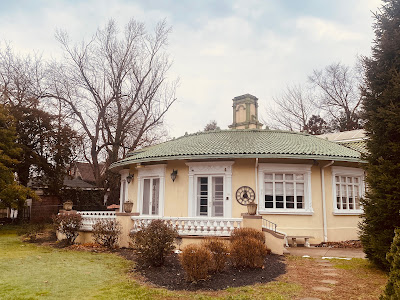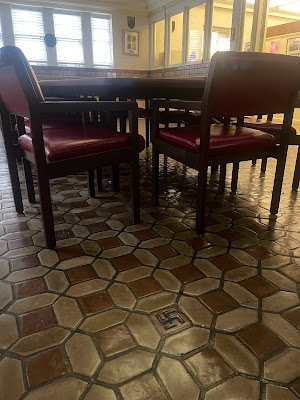 |
| Swastika tile in the Solarium hallway at Diocesan HQ, photo by Jolyon Pruszinski (September 23, 2023) |
 |
| The "Solarium" at the Diocesan HQ, photo by Jolyon Pruszinski |
Wetzel was the original owner and commissioner of the buildings. While the oldest building in the complex dates to 1912, the Solarium was the last built and was not built until 1935, that is, well after the Nazi party had appropriated and publicly promoted the use of the swastika symbol. It is true that some early-20th century swastika tile manufacturing and use in the United States pre-dates the Nazi regime in Germany, and did not originally have a Nazi association,[2] but the date of the construction of the Solarium, as well as the proportional density of use of the swastika tiles, suggests likely intent in this instance to communicate Nazi sympathies through the design.[3]
 |
| Swastika tile in the Solarium conference room, Diocesan HQ, photo by Jolyon Pruszinski (September 23, 2023) |
However, whether the original use of the symbol in the building was accompanied by a knowledge of the full scope of murderous Nazi racist ideology at the time, or even had any Nazi affiliated intent is, in truth, irrelevant. Whether the swastika has a pre-history before the Nazi regime is also irrelevant, as is whether the construction of the building predates the Nazi regime. The issue is that the building is currently in use within the current universe of symbolic meaning, not that of pre-WWII America, and the symbols in their current American use communicate White-supremacist meaning[4] and threaten all those targeted by white-supremacist ideology. Many visitors to the building, including children, have found the presence of the swastikas very upsetting.
The complacency regarding racism that has allowed the tiles to stand undisturbed for over 80 years in the headquarters of the diocese has been on display in other ways as well. Nazi-sympathetic priests have been allowed long tenures in the diocese.[5] For most of the history of the diocese the leadership have assumed that the Episcopal Church is for White people.[6] Bishop Doss was publicly accused of racism in the 1990s, but only ousted for other reasons.[7] And as the diocese has developed, in general it has cooperated with and often sanctioned racist policies and patterns in society.[8]
Moreover, this issue is neither unprecedented, nor difficult to remedy. In several instances other institutions, including churches, have managed to muster the energy to remove swastika tiles[9] from their buildings in acknowledgement of the current white-supremacist associations with the design.[10] In some Anglican-influenced countries, such as Australia, public displays of swastikas are actually illegal.[11] Further, the tiles at the diocesan headquarters are not a structural feature of the building and removal would neither be difficult, nor require a large outlay of funds.[12] Historic preservation concerns are incidental[13] in comparison to the primary concern of whether the tiles currently communicate white-supremacist ideology (they do) and function to threaten the targets of said ideology (they do).
In its drafted Convention Resolution on the subject (which the Commission chose not bring before the Convention), the Reparations Commission stated that to continue to display White-supremacist symbols which currently communicate racist ideology and which currently operate to threaten both Jews and African Americans constitutes a continuation of a decades-long violation of the Episcopal baptismal covenant.[14] In accord with the language of that draft resolution, the Reparations Commission continues to insist that the swastika tiles be removed before the end of 2024 and that at least one tile be preserved and displayed with interpretive historical material prepared by the Commission to document this unfortunate history.
[1] See Laurence D. Fish, “Diocesan House,” a diocesan statement written by the former diocesan historiographer (b. 1929, d. 2010). The manuscript is held at the diocesan archives, also at 808 West State Street, Trenton, NJ 08618. The first time I saw the swastikas I asked a diocesan official about them and she handed me this document with no accompanying explanation. The document states the following: “This property at 808 West State Street originally consisted of a house built in 1912, a Casino built in 1927, and a Solarium built in 1935. The original owner was Frank J. Wetzel, the inventor and manufacturer of the Wetzel Mechanical (Coal) Stoker. By 1927 Wetzel found it necessary to entertain prestigious visitors he met in his role as special representative to the Board of Directors of the Pennsylvania Railroad. Consequently, in 1927 he built the casino and swimming pool to meet those entertaining needs. The Casino was designed and constructed by an architect named William W. Slack. By 1935 the Wetzel property consisted of the house located on one 50’ wide lot facing West State Street and three 50’ lots that face Carteret Avenue. The Solarium was designed and built by Slack in 1935 and is the present large meeting room. In 1936 Wetzel bought the 100’ lot from E.C. hill that was immediately adjacent to the Wetzel home. This resulted in property consisting of six building lots that totaled frontage of 150’ and a depth of 200’. In order to give himself some empty space near his home, Wetzel demolished the Hill mansion and space remains open. Wetzel died in 1940 and his widow, Anna R. Wetzel, retained the property until 1942 when she signed it back to the First-Mechanics National Bank. The bank advertised the property for sale and the Diocese bought it in 1943. The bank’s original asking price was $40,000 and the Diocese bought it for $25,000.”
[2] Thanks to Rev. Jack Zamboni for his research suggestions in this area. A rather exhaustive treatment of the issue is available at https://en.wikipedia.org/wiki/Western_use_of_the_swastika_in_the_early_20th_century.
[3] Even in the 1920s the design had already come to be associated with “Aryan conquest and mastery.” See Robert Lavenda, "A History of Swastikas," Insights for a Diverse Campus Community (Spring 2005): 3, now archived at https://web.archive.org/web/20120129173019/http://www.stcloudstate.edu/affirmativeaction/resources/insights/pdf/Insights-Vol2-Issue4.pdf.
[4] As noted by the Anti-Defamation League in https://www.adl.org/resources/hate-symbol/swastika (last accessed January 9, 2024). The work done in the Episcopal Church to begin to reckon with its history of production and preservation of similarly problematic Confederate symbolism emphasizes the importance of consideration of current meanings in the use of symbols in the Episcopal Church: https://www.episcopalnewsservice.org/2019/08/06/sewanee-workshop-to-guide-priests-grappling-with-confederate-symbols-in-their-parishes/ (last accessed January 9, 2024).
[5] Such as Rev. Dr. Ridgeway of St. Wilfrid’s, Camden. See Stephanie Fanjul, “St. Wilfrid’s Church: Fragments of the Soul of an Urban Church,” Capstone Project (2019), MSS held at Rubenstein Library, Duke University, https://hdl.handle.net/10161/18575 (last accessed 1.10.24).
[6] See, for example, Nelson K. Burr’s, The Anglican Church in New Jersey (Philadelphia: Church Historical Society, 1954). Burr was a long-serving member of the Standing Committee in the Diocese of New Jersey. In his commentary on demographic trends in the state (e.g. Table IV, pp. 483-84) he goes beyond his default assumption throughout the book that the Episcopal Church is basically just for White people and explicitly claims that immigration from southern and eastern Europe are an obstacle to the growth of the Episcopal Church, showing his conviction not only that the Church is just for White people, but that it is only for northern and western European White people. Black people have been treated as an “anomaly,” to borrow the language used by Black Episcopal historian Harold T. Lewis in his Yet with a Steady Beat: The African American Struggle for Recognition in the Episcopal Church (Valley Forge, PA: Trinity Press, 1996), 10.
[7] See https://religionnews.com/1997/01/01/news-story-new-jersey-episcopal-bishops-resignation-sought/ and https://www.nytimes.com/1997/12/07/nyregion/embattled-episcopal-bishop-his-ouster-sought-leaders-new-jersey-diocese.html.
[8] See details in Jolyon G. R. Pruszinski, “Reparations Commission Address, 2024 Diocesan Convention,” Diocese of New Jersey Racial Justice Review (March 6, 2024), https://dionj-racialjusticereview.blogspot.com/2024/03/video-reparations-commission-address.html. There have been various justifications for inaction on the tiles that have been offered over the years that fit with these patterns.
[9] These are just instances of tile removal specifically.
[10] Including St. Lawrence Catholic Church in Lafayette, IN (See the AP report of March 23, 1996, archived at https://news.google.com/newspapers?nid=1350&dat=19960323&id=ixwqAAAAIBAJ&pg=6058,7013834), St. Mary’s Cathedral in St. Cloud, MN (See reporting from the St. Cloud Times of May 3, 2006), and Rockville Centre Cathedral, Rockville Center, NY (See Kevin Vesey, "Swastika-like tile designs found inside prominent Catholic church in Rockville Centre," originally published at Fios1News.com [April 18, 2016], now archived at https://web.archive.org/web/20160422200444/http://www.fios1news.com/longisland/swastika-like-symbols-removed#.VxqD5C_P32c). There are many more instances of institutions other than churches removing these kinds of symbols as well.
[11] See, for example, recent reporting on the relevant laws in Australia: https://news.yahoo.com/australia-bans-nazi-salute-public-012255773.html, (last accessed January 9, 2024).
[12] There are approximately twenty swastika tiles currently exposed, each with ample grout surrounding them, allowing ease of removal. There may be an equal additional number under the cubicles in the office space of the central Pool House room. According to widely available online cost calculators, tile replacement projects of this scale are a modest price.
[13] There is a long history of historic preservation concerns being used as the official rational for public decisions in order to mask the real reasons for those decisions. For documentation of on instance of this see, for example, Michael Gecan, Going Public: An Organizer’s Guide to Community Action (New York: Anchor, 2004), 69-71.
[14] Most explicitly, the vows to “persevere in resisting evil,” to “love your neighbor as yourself,” and to “strive for justice and peace among all people, and respect the dignity of every human being” (Book of Common Prayer, pp. 304-5).